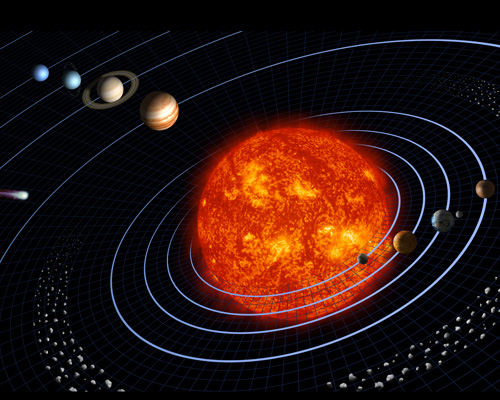About Lesson 11

Figure 11.1: "Our solar system features eight planets, seen in this artist's diagram....This representation is intentionally fanciful, as the planets are depicted far closer together than they really are. Similarly, the bodies' relative sizes are inaccurate. This is done for the purpose of being able to depict the solar system and still represent the bodies with some detail. (Otherwise the Sun would be a mere speck, and the planets -even the majestic Jupiter-would be far too small to be seen.)"
Credit: NASA/JPL
By the end of Lesson 11, you should be able to:
- Compare and contrast the interior structure and atmospheres of Mercury, Venus, Earth, and Mars;
- Qualitatively describe the process of tidal locking and relate this phenomenon to Mercury’s orbit around the Sun and the Moon’s orbit around the Earth;
- Describe the role impacts and collisions had on the evolution of the Inner Solar System planets and the Moon;
- Compare and contrast the terrestrial planets and the Jovian planets;
- Describe the processes for the formation and evolution of ring systems around giant planets;
- Compare and contrast the moons of the Jovian planets;
- Relate the appearance of the Jovian planets to atmospheric processes;
- Describe the relationship between Pluto and the Kuiper Belt;
- Explain the origin of comets and their distribution in the Solar System;
- Describe the process by which a “shooting star” appears in the night sky.
What is due for Lesson 11?
Lesson 11 will take us two weeks to complete.
Please refer to the Calendar in Canvas for specific time frames and due dates.
There are a number of required activities in this lesson. The chart below provides an overview of those activities that must be submitted for Lesson 11. For assignment details, refer to the lesson page noted.
| Requirement | Submitting your work |
|---|---|
| Lesson 11 Quiz | Your score on this quiz will count towards your overall quiz average. |
| Unit 4 Lab | During Lesson 11, you will work on, and complete, the Extrasolar Planets lab (Lab 4). |
Questions?
If you have any questions, please post them to the General Questions and Discussion forum (not email). I will check that discussion forum daily to respond. While you are there, feel free to post your own responses if you, too, are able to help out a classmate.